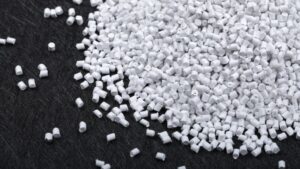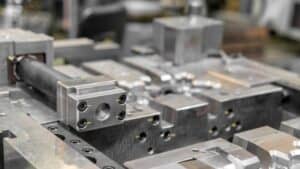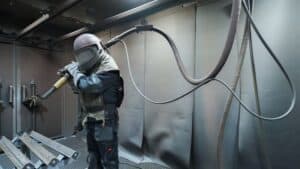Two different plastic resins are molded together in a single machining cycle during the double injection molding process, also known as dual shot, double shot, multi shot, and overmolding.
A cutting-edge manufacturing technique called double injection, also known as two-material, two-shot molding, or two-K molding, is used to create intricate molded parts from two different materials.
During the two shot injection molding, we carefully control the injection of numerous materials, including two distinct types of resin, into a single, multi-chambered mold using a highly specialized and automated technique.
Two Shot Molding Process
An injection molding machine is used in the two shot molding process where two materials are “over molded” in one molding cycle. The amount of material injected into the molding cavity is referred to as a “shot.”
In two shot injection molding, a first section is molded, and after it is complete, a second part is injected to create the molding’s final portion. Both pieces must be comparable (chemically) for the two shot molding process to be successful for bonding to take place.
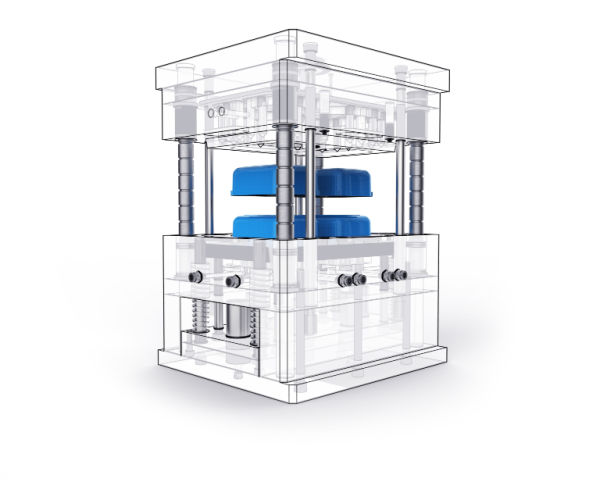
A part made of hard material can be joined to a part made of soft material using two shot injection molding. In a two cavity mold, the procedure combines the molding of two components. It can significantly improve the product’s appeal in terms of feel, color, etc. There are many different design possibilities with two-shot molding.
The two shot injection molding technique is divided into two steps. The first involves an injection of resin into a mold, which is then cooled to create a solid object, much like traditional injection molding.
The newly-molded object is transported to a second mold in the second stage using a rotating platen or a robotic arm. Depending on the design, the newly-molded part is then given a second injection of resin in, through, or around specific areas of the first mold.
Following the formation of a molecular link between the two plastic resins, the multi-resin molded object is cooled and expelled.
Although the procedure is simple to grasp, mastering it is challenging. Even the tiniest errors can result in significant financial losses because of the high levels of technical competence and attention to detail required, especially in high-volume manufacturing circumstances.
This is why choosing a supplier with exceptional skills is important. Excellent supplier quality scorecards established processes to prevent flash, flow lines, short-shots, and backup plans from increasing capacity as your company and your needs for two shot molding expansion are all things to look for.
This process makes two shot molding ideal for switches, buttons, toothbrushes, and caps for containers.
Applications Of Two Shot Molding
For intricate, multiple colors, and multi-material plastic goods, especially in high-volume manufacturing circumstances, two shot injection molding is the best plastic molding technique.
In addition, the two shot molding process is applied in the automotive sector to make a wide range of products and parts. Other items made using the double shot process include lawn and garden tools and agricultural equipment.
Two shot molded parts are utilized in almost every industry, from consumer goods to construction, but they are most frequently used in situations needing the following:
- parts or components that can move
- rigid surfaces with flexible grips
- either acoustic dampening or vibration
- superficial explanations or identifications
- components with several materials or colors
Ideally, the two shot injection molding process is used for complex parts that have multiple components.
Benefits Of The Two Shot Molding Process
Plastic polymers are utilized in a range of production processes, such as extrusion, compression thermoset molding, and two shot injection molding. While each is a feasible manufacturing method, many plastics manufacturers use this method due to several advantages.
In order to create the first segment of the product, one material is first injected into a mold. A second injection of a secondary material compatible with the first follows this. There are several reasons why many businesses choose to produce plastics or polymers this way.
Here are some benefits of the two shot molding process:
Versatile
Product makers prefer two shot injection molding for a variety of applications, including automotive interior parts, medical equipment, tools, and toys. It enables manufacturers to mix a multitude of components and hues to produce a robust and aesthetically pleasing product.
Materials like silicone and thermoplastics, nylon and thermoplastic elastomers, or stiff nylon and soft touch materials are a few examples of materials that can be blended successfully with this procedure.
Cost Effective
With the first mold rotated out of the way and the second mold placed around the product so that the second compatible thermoplastic can be injected into the second mold, the two-step procedure only requires one machine cycle.
The method produces more products each run for less money and requires fewer workers to produce the completed product since it uses a single machine cycle rather than multiple machine cycles. Additionally, it guarantees a solid binding between the materials, eliminating the need for later assembly.
High Product Quality
The majority of thermoplastic products benefit from two shot injection molding in numerous ways:
- Enhanced aesthetics. When products are made of different colored plastics or polymers, they look nicer and are more enticing to consumers. The product will appear more expensive if more than one color or texture is used.
- Better ergonomics. The method allows for soft touch surfaces; thus, the finished products can have handles or other ergonomically developed sections. This is crucial for tools, medical equipment, and other portable objects.
- The seal is improved when silicone polymers and other rubbery materials are used for gaskets and other parts that need a tight seal.
- It enables hard and soft polymers to produce items of the tiniest size that provide exceptional comfort and utility.
- When compared to over-molding or more conventional insert methods, it can significantly lower the number of misalignments.
- It allows producers to use several materials that can’t be efficiently bonded using other procedures to create more intricate mold patterns.
- The bond formed is incredibly strong, making the final product more robust, dependable, and long-lasting.
The two shot molding process helps manufactures achieve high-quality products.
Part Consolidation
The number of parts in a finished assembly is decreased using two shot injection molding, saving an average of USD$40K in development, engineering, and validation expenditures for each increased part number.
Efficient
With two shot molding, several components can be molded with a single tool, requiring less work to produce your parts and no post-molding welding or joining of the components.
Types Of Two Shot Molding Structures
Choosing and ending up with the proper mold structure is essential to save on costs and ascertain quality. Here are some types of two shot molding structures:
Core Toggle Two Shot Mold
Because the mold’s core and cavity do not need to be relocated, the core toggle multi shot molding procedure is the simplest. Alternatively, shifting the slider will alter the geometry of the mold cavity.
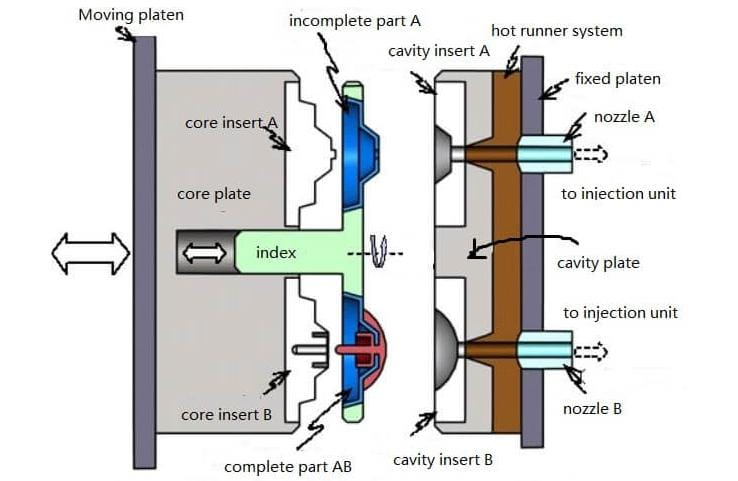
Substance A is first injected into the cavity when the slider is in its expanded position during the injection molding process using the core toggle two shot mold. Then pulling the slider back to expose a new area of the cavity.
The remaining space is filled by moving the slider after material B is injected into the modified cavity through a different gate (above the middle nozzle).
The plastic component is then forced out of the mold after hardening. Circulated in the same order as above to continue the molding.
Although the tool’s price increases when a slider is added to the mold, it can still be significantly less expensive than rotating platen or rotary shaft molds. Sadly, it is unable to make intricate, multicolored plastic pieces.
Rotary Platen Two Shot Mold
On the centerline of the platen, which parallels the axis of rotation, the mold core plate has two identical cores that are mirror images of one another. Two cavities with various geometries are included in the cavity plate attached to the fixed platen.
The rotary platen completes the switching of the molded pieces in each cycle, doing so without human switching.
The mold, which can hold more materials, is only seen here with the two materials. Depending on how much material is utilized, the rotating platen can be rotated by 90°, 120°, or 180°. A specific injection machine is also required to produce the necessary rotation on the core side.
Seesaw Two Shot Mold Structure
With one side moving up, the other side moving down, and so on, the slab structure is made up of two sides rotating around the center. Most keyboard mold designs with numbers and letters use the seesaw structure.
The structure contains closed numeric or alphabetic characters like 0, 4, 8, A, B, D, and O. The secondary material can only easily enter the confined region when a seesaw construction is used, creating a lovely appearance.
The seesaw structure functions as follows:
- After one injection, the mold is opened.
- The broken needle is lowered by the push rod, causing the seesaw to revolve around the rotating shaft.
- The top plate is pushed up by pushing the seesaw, causing the broken needle to emerge from the mold.
A broken hole is created as the needle rises at the edge of the sealed-off portion of the primary product. To drill the secondary material into the closed area from the broken hole, the needle is moved lower by the returning pin of the fractured plate during the double injection molding process.
Cavity Sliding Structure
The male model cavity glides under the influence of the motor as the mold is opened after one injection. A specified distance is used to align the mold with the master mold before the second injection molding process.
Factors To Consider When Using Two Shot Molding
The following factors are considered when using double shot molding:
Material Selection
Physical, mechanical, chemical, thermal, electrical, flammability, and UV resistance are all important considerations when selecting a material for your component. You’ll need to provide answers to a number of questions in order to focus your material selection, including:
- What kinds of temperatures will your product be subjected to?
- How flexible or rigid do you need the material to be for bending?
- Impact resistance: How robust must its surface be?
- How well does it withstand big loads in terms of compression strength?
- Will the component be exposed to UV rays, such as those found outside?
- Will the part be exposed to chemicals that will affect how well it works, especially over time?
- What sort of shelf life is required for the part?
Material Compatibility
The chemistry of the materials is crucial to take into account when deciding which ones to utilize for two-shot molding. While some materials bind imperfectly, others work well together and create a solid molecular adhesion.
Conduct an adhesion test before beginning manufacturing when the adhesive property of two compounds is unclear. When bonding is insufficient, fixes can be incorporated into the design, such as undercuts, grooves, or shoulders, to increase adhesion and lock the two compounds together.
A material compatibility table is reviewed to determine which polymers will cling to one another and which polymers are incompatible. Additionally, it eliminates the possibility of contamination, which is an issue when utilizing two different molds.
In addition, compared to producing an identical product or part using two different molding processes, the two shot molding procedure results in a much stronger bond. The ability to make multicolored plastic goods using the two-shot molding method is one of the process’ additional advantages over painting, which may lose its effectiveness over time.
You may create more useful, sophisticated elements using the two shot approach. Further, softer plastic may be mixed with hard plastic. The product has significantly greater integrity. Two-shot plastic molding products are often far more durable and shockproof.
The method is also excellent for making soft handles for electrical equipment, air conditioning seals and gaskets, and non-slip surfaces. With this method, logos may be created that, unlike painted-on logos, would never fade.
Shut Offs
To form holes, snap features, and lengthy through-holes, the mold closes these places to prevent plastic flow into those locations.
In these situations, the mold’s two halves seal against one another. Due to this, the sealing faces of the mold can open and close without colliding with one another. Three to five degrees should be the minimum draft angle. The longer the mold lives, the higher the clearing and the greater the draft.
Gate Type
The melted resin enters the mold chamber through a gate channel when using injection molding. To achieve the ideal part proportions and aesthetic look while preventing warping, the type of gate, design, and location must be taken into account.
Tab and hot-runner gates are the two kinds of gates used in injection molding the most frequently:
- The most popular and efficient gates are tab gates; however, because they are so straightforward, they might not be appropriate for your needs.
- Hot tip gates feature tiny elliptical apertures. The resin is kept hot enough to pass through the narrow gate hole by the thermostat-controlled heater attached to the back of the mold.
Molecular Chemical Bonding
For a strong molecular bond to be possible, your substrate and second-shot resin should ideally be chemically compatible. The longest leg or surface area is ideal for the joint between the two resins. The second shot is nearly impossible to remove by selecting the ideal materials and joint design.
Even when a high-level chemical bond may be achieved, we highly advise using an appropriate mechanical bond if bonding is important to your application.
Gate Location
This is essential for producing solid surface cosmetics and a homogeneous mold. In single-shot injection molding, the melt can enter through the thickest part of the opening before flowing to the smaller areas, thanks to the gate’s placement.
Suggestions For Two Shot Molding
Here are some recommendations for two shot molding:
Number 1
The soft plastic is molded a second time after being first molded as hard plastic. The first time is transparent; the second time isn’t. The first molding is done with a high temperature plastic, while the double molding is done with a low-temperature plastic.
Number 2
Test the mold to create a finished product before the actual production.
Number 3
Before the mold is made, find all potential flaws and fix them.
Number 4
Take into account the two materials’ shrinking. Generally speaking, the material that is initially created affects shrinkage.
Number 5
A second injection can only be given once the first has fully taken effect.
Number 6
To avoid damage during the molding process, consider the molded position.
Number 7
Permit the first injection-molded part’s edge to be excessively large. This assures that the second injection will have a higher pressure.
Number 8
Verify that the injection unit’s parameters give the necessary pressure, flow rate, and cooling capacity.
Number 9
Make sure the first molded part’s structural integrity can survive the injection pressure of the second molding.
Conclusion
People who are unfamiliar with two-shot injection molding might think it’s difficult. It does involve a second material and procedure, which adds another factor to component creation, but it’s relatively easy.
Two-shot molding can be done using rotary platen, movable core, or overmold, among other options. The first two require two processes, two runner systems, and a second injection unit.
The latter often uses two different molds, one for each material, but can also be carried out using just one mold, two runner systems, and manual or automated pick-and-place part transfer.

